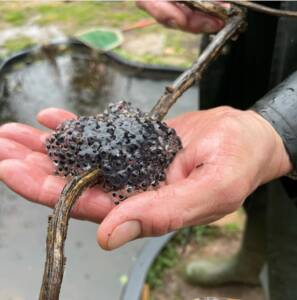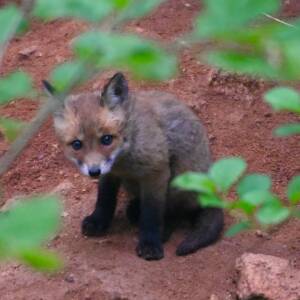VERNAL POOLS (photos by Mia Walsh)
The evening rains added to a vernal pool formed along the floodplain of Minebank Run. A week before the water was frozen and lifeless, but on this morning the water ripples and bubbles emerge from the pool’s leafy bottom. Fed by winter precipitation and high ground water, seasonal pools like this become critical habitats to many species of amphibian and insects.
A Carolina wren hops along the muddy edge of the pool, picking through the leaves in search of a quick meal. The water ripples at the wren’s approach as a wood frog dips under the surface, startled by the movement.

The wood frog, along with several others, ventured from the shelter of a rotten log or leaf pile where it spent the winter, in search of this pool. Soon the pool will be alive with the sounds of the duck-like croaks of the wood frogs as they advertise for their mates during this short and frenzied breeding period.
Often the first of the amphibians to enter the pools, the wood frogs sometimes get caught by late winter freezes. Fortunately, the wood frogs have evolved to deal with this setback to the spring season. When confronted with freezing conditions, whether in the vernal pools or their overwintering location, they have the ability to increase the concentration of glucose within their blood which acts like an antifreeze, protecting their blood vessels from bursting and from dehydration that comes with being frozen. Though much of their body freezes and their heart and lungs stop functioning, the frogs survive the freezing conditions and re-animates once the temperatures warm. cool info
 The strategy of being an early arriver at the vernal pool is beneficial in that the earlier the frogs can mate and lay eggs the more time their young will have to develop from the aquatic tadpole stage to the terrestrial frog stage. Vernal pools, as the name implies, are only present in late winter and spring, drying up as spring proceeds to summer. A later start to the breeding season could mean that the pool dries before the tadpoles are ready, leaving them stranded on the drying soil. They will either succumb to the dryness or become a meal for a wide variety of predators.
The strategy of being an early arriver at the vernal pool is beneficial in that the earlier the frogs can mate and lay eggs the more time their young will have to develop from the aquatic tadpole stage to the terrestrial frog stage. Vernal pools, as the name implies, are only present in late winter and spring, drying up as spring proceeds to summer. A later start to the breeding season could mean that the pool dries before the tadpoles are ready, leaving them stranded on the drying soil. They will either succumb to the dryness or become a meal for a wide variety of predators.
The upside of using vernal pools is that the temporary waters cannot support fish, a major predator to amphibians and their eggs. In the wild there are always trade-offs. American toads, green and bullfrogs, by comparison, have evolved to use permanent pools for their breeding, braving the dangers of fish to avoid the dangers of drying waters.
The water of the pool ripple ripples as a wood frog floats to the water surface. Sprawled across the water with its legs stretched out behind, its tan back and black face mask show just above the water line. Wood frogs coloring may range from dark brown to reddish but is typically tan. The black face mask is usually present and is defining field mark. The wood frog bobs in the water and lets loose its un-frog-like croak. Not the typical “ribbit” or “peep” of other frogs or the trill of the toad, the wood frog call is something more of a duck’s quack. At a distance a chorus of wood frog can sometimes even sound like a flock of calling crows. At this time of year, vernal pools can be located simply by following the calls of the frogs.
The sun warms the morning air, and the rising temperatures stir the frogs to action and the pool erupts with their calls. The water surface roils with their movements as males call and chase after willing females. The males, excited by the opportunity to mate, grapple amongst themselves in search of a willing and able female. Feeling their way through the pool, the males use their front legs to grab onto the torso of any passing body. They can tell by the “hefty-ness” of the body that they have grabbed whether their “partner” is suitable for mating. Males and females that have already mated are thinner than the suitable female ready to lay eggs.
 A red fox trots by the vernal pool and its movement brings the cacophony of the pool to an immediate stop, silence again prevails. One cold days it may be many minutes before the calls begin again, first one then two then the whole pool croaking together. On warm sunny days the bravest, or most carefree, of the frogs will beginning calling right away, driven more by the opportunity to mate than restrained by the fear or predation.
A red fox trots by the vernal pool and its movement brings the cacophony of the pool to an immediate stop, silence again prevails. One cold days it may be many minutes before the calls begin again, first one then two then the whole pool croaking together. On warm sunny days the bravest, or most carefree, of the frogs will beginning calling right away, driven more by the opportunity to mate than restrained by the fear or predation.
The fox wanders off and quickly the waters in the vernal pool come to life with activity in the dappled sunlight of the forest floor. Soon the surface of the pool will be filled with the gelatinous masses of the frog’s eggs. Unlike the spotted salamanders that share these pools, the egg mass of the wood frog includes individual egg sphere for each larva. The salamander egg mass is a single large jelly-like blob with many larvae. When first laid both egg masses are clear, and the larvae easily seen. As the egg masses age, they become opaque.
 A red-shouldered hawk alights on a nearby branch and peers down to investigate the pool. A frequent consumer of amphibians and snakes, the pool may provide a quick meal. A loud “kee-ahh” call of another red-shouldered hawk rings out from the ridgeline forest and the hawk’s attention is quickly redirected. Defending its territory takes precedence over a meal at the moment. Though still winter on the calendar, the instinctual drive of spring is in the air.
A red-shouldered hawk alights on a nearby branch and peers down to investigate the pool. A frequent consumer of amphibians and snakes, the pool may provide a quick meal. A loud “kee-ahh” call of another red-shouldered hawk rings out from the ridgeline forest and the hawk’s attention is quickly redirected. Defending its territory takes precedence over a meal at the moment. Though still winter on the calendar, the instinctual drive of spring is in the air.
